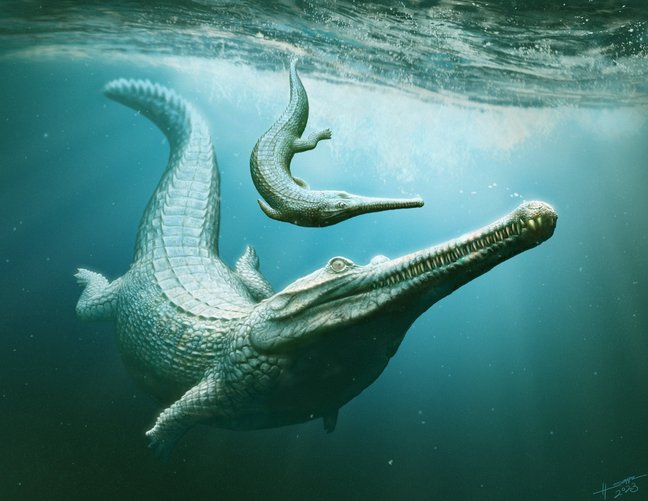Stuttgart, 12.10.2023. The State Museum of Natural History Stuttgart has a globally important collection of marine reptiles with numerous specimens from the time of the so-called Posidonia Shale. The outstanding feature of the ca. 183-182 million year old fossils of ichthyosaurs, marine ‘crocodiles’ (or thalattosuchian crocodylomorphs) and fishes from southwestern Germany is their extremely good, often complete preservation. The fossils are therefore not only beautiful exhibits, but also invaluable to science. Based on sixty-two fossils from the Posidonia Shale, a team from the State Museum of Natural History Stuttgart led by paleontologist Dr. Michela Johnson, conducted a study on the growth rate of the marine crocodile Macrospondylus bollensis. This work represents one of the first studies on the growth of marine crocodiles known as teleosauroids. In their analyses, the scientists found that much of the body in these crocodiles grew isometrically. This means that in Macrospondylus bollensis many parts of the body show a near-uniform growth in all age stages in relation to the total growth. This is very unusual in vertebrates. The research results have now been published in the journal “Papers in Palaeontology”.
The teleosauroids represent a successful, nearly worldwide group of marine crocodilians from the Early Jurassic to the Early Cretaceous, and were particularly common in the 182 million year old Posidonia Shale Formation in Southwestern Germany. How these animals grew from a fifty-centimeter baby to a five-meter adult has been little studied. In their study, the paleontologists examined the growth rates of the most abundant teleosauroid, Macrospondylus bollensis, because several body sizes and biological growth stages of the animals have been preserved in the Posidonia Shale of southwestern Germany. Many fossil specimens of the animals are in the collections of the Stuttgart Museum of Natural History. The scientists performed statistical analyses on sixteen juveniles, seven subadults, and thirty-nine adult specimens of Macrospondylus. Twenty-one cranial and skeletal measures were included.
"The most important finding of our study is that juvenile, subadult and adult individuals show nearly equal growth in many areas of the body. We also call this isometric growth, which is unusual in vertebrates. But that's why Macrospondylus juveniles look quite similar to adults," said Dr. Michela Johnson. In many vertebrates, individual body parts, such as the legs, grow either faster or slower than other parts of the body. The analyses also show that the scaling of the limbs in Macrospondylus is different from that of modern alligators and crocodiles, but comparable to that of the now critically endangered Indian gavial, Gavialis gangeticus. Why isometric growth was present in Macrospondylus bollensis is still unclear. "Our study raises new questions about the ecology and lifestyle of these animals, which we hope to clarify with further research," said Dr. Michela Johnson.
For editors:
Original publication: Johnson MM, Amson E, Maxwell EE. 2023. Evaluating growth in Macrospondylus bollensis (Crocodylomorpha: Teleosauroidea) in the Toarcian Posidonia Shale, Germany. Papers in Palaeontology. https://onlinelibrary.wiley.com/doi/full/10.1002/spp2.1529
DOI: https://doi.org/10.1002/spp2.1529
Published: 11.10.2023
Image material:
Picture 1: Illustration_Macrospondylus bollensis, Henry Sutherland Sharpe.jpg.
Description: A mother Macrospondylus bollensis keeps a watchful eye on her young. Illustration by Henry Sutherland Sharpe.
Copyright notice: Henry Sutherland Sharpe.
Picture 2: Picture2_ Macrospondylus bollensis _Collection SMNS, SMNS, M.Rech.jpg
Description: Michela Johnson in front of the fossil of a Macrospondylus bollensis in the collections of the State Museum of Natural History Stuttgart. The fossil is from the Posidonia Shale and is about 182 million years old.
Copyright notice: SMNS, M. Rech
Picture 3: Picture3_fossil_crocodile_collection_SMNS_SMNS, S. Krassovitski.jpg
Description: The fossil of a young marine crocodile in the collections of the State Museum of Natural History Stuttgart.
Copyright notice: SMNS, S. Krassovitski
Please note that use of the photographic material is only permitted if the copyright is acknowledged. Thank you.
Contact:
Dr. Michela Johnson
State Museum of Natural History Stuttgart
Department of Paleontology
Tel. 0711 - 89 36 - 168
E-Mail: michela.johnson(at)smns-bw.de
Press contact:
Meike Rech
State Museum of Natural History Stuttgart
Tel. 0711 - 89 36 - 107
E-mail: meike.rech(at)smns-bw.de
State Museum of Natural History Stuttgart:
The State Museum of Natural History Stuttgart is a forward-looking research and communications institute. Its research collections, the archives of diversity, contain over 12 million objects. The museum researches the evolution of life and analyzes the biodiversity of different ecosystems and communicates research findings to the general public. It is also strongly committed to training the next generation of young scientists.
